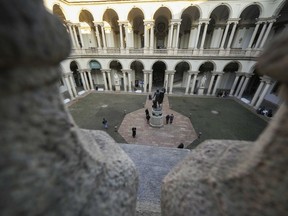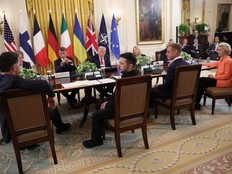Milan’s Brera boosts cultural cachet with modern art wing and Leonardo’s Last Supper
Pinacoteca di Brera museum was conceived under Napoleon as a 'little Louvre'

Article content
Reviews and recommendations are unbiased and products are independently selected. Postmedia may earn an affiliate commission from purchases made through links on this page.
MILAN — Milan’s Pinacoteca di Brera museum, conceived under Napoleon as a “little Louvre,” is finally getting a modern art addition first envisioned more than 50 years ago with the recent reopening of Palazzo Citterio, home to one of the world’s most important collections of 20th century Italian art.
Completing the project long beset by shifting priorities, periods of neglect and most recently an ill-fated architectural vision was a priority for Brera director Angelo Crespi when he took over in January.
The Palazzo Citterio opening completes a decades-old vision for a “Grande Brera,” which encompasses also the Pinacoteca and the Braidense National Library, just as it takes on greater heft in the Italian cultural landscape.
From Dec. 2, the Grande Brera also incorporated into its fold Leonardo da Vinci’s “Last Supper,” arguably Italy’s most famous masterpiece. The fragile wall mural is located in a church complex a kilometer (half a mile) away from the Pinacoteca and Palazzo Citterio.
The merger creates a system of state-run museums in Milan that boosts Brera’s cachet and gives Crespi significant autonomy in their management, including control over 80% of revenue.
Combined, the “Last Supper,” and the Pinacoteca di Brera, receive 1 million visitors a year, and take in more than 10 million euros (C$15 million) in revenue, Crespi said. As a single entity, they are among the top 10 most-visited sites in Italy.

Crespi hopes to use this greater visibility to promote other institutes in the Brera complex, including the Academy of Fine Arts, botanical gardens and an observatory, while also pitching Milan — better known for fashion and finance — as a city of the arts.
Beside the Grande Brera’s vast collections and the “Last Supper,” masterpieces by Michelangelo, Canova, Caravaggio, Raffaello, Bellini, Piero della Francesca and others are displayed in museums and landmarks within walking distance of Milan’s central Duomo cathedral. Yet they are often overlooked by visitors.
“All of the biggest masterpieces and names who made Italian art great over the centuries are concentrated within a few hundred meters,” Crespi said, adding that as an art city, Milan can rival Florence, Rome and Venice.
The Grande Brera should become “the motor of this narration of Milan as a city of art,” he said.
By spring, the Pinacoteca di Brera will be linked to Palazzo Citterio, a few minutes’ walk away, by a passageway through the botanical gardens behind the museums.

Inside Palazzo Citterio, visitors are greeted by the monumental late 19th century painting “Human Flood,” by Giuseppe Pellizza da Volpedo, intended as a bridge from the Pinacoteca’s collection that is rich in Italian Renaissance and Baroque art taken from areas conquered by Napoleon’s army.
In the new museum, hundreds of artworks donated to the Brera decades ago by the art collectors Emilio Jesi and Lamberto Vitali form “a manual of Italian contemporary art,” with a particular focus on Giorgio Morandi, said curator Marina Gargiulo.
Jesi, who lived in an apartment in the palazzo, focused his collection on painters who were his contemporaries in the 1930-1960s, most of them Italian artists, with notable exceptions including Picasso.
Vitali’s tastes were more eclectic, ranging from archaeological artifacts to Byzantine mosaics and art from the medieval era through the 20th century, with paintings by his friend Morandi and by Modigliani, Gargiulo said.
The new museum also includes a series of 152 miniature self-portraits commissioned by Italian neorealistic screenwriter Cesare Zavattini.
For now, the Palazzo Citterio will be open Thursday-Sunday from 2 p.m.-7 p.m., while the Pinacoteca di Brera is open Tuesday-Sunday from 8:30 a.m. until 7:15 p.m. Reservations are recommended for Leonardo’s Last Supper Museum, open from 8:15 a.m. to 7 p.m. Tuesday-Sunday, with a maximum 40 people admitted every 15 minutes.











Postmedia is committed to maintaining a lively but civil forum for discussion. Please keep comments relevant and respectful. Comments may take up to an hour to appear on the site. You will receive an email if there is a reply to your comment, an update to a thread you follow or if a user you follow comments. Visit our Community Guidelines for more information.